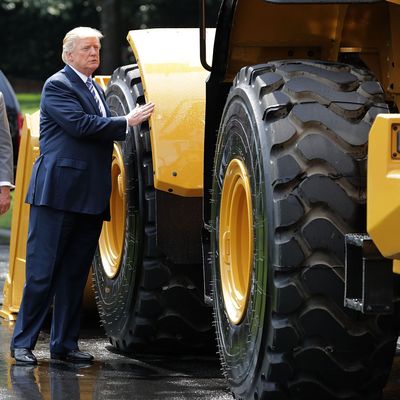
Back in February, I wrote about an odd split in the economic data that seemed to be leaving investors unsure whether to buy or sell. Data about employment — job creation and wage growth — looked pretty strong. But data about output — like retail sales and gross domestic product — looked worrying. Which kind of data provided the better signal about the economic outlook?
In the ensuing two months, we got our answer: Somewhere in the middle, but much closer to what the employment numbers were telling us than the output numbers. The jobs data has cooled off a little bit — February’s numbers were weak, though March looked good again — but the output data has gotten much stronger. In particular, retail sales soared in March, erasing the nosedive in December that got people so worried. The various data now align around an expectation that the economy will continue growing, albeit at a modestly slower pace than it grew last year, when we were enjoying a “sugar high” from the tax cut.
And the stock market has soared again, fueled partly by this positive clarity on economic expectations, and partly by clarity from the Federal Reserve that it won’t be raising interest rates anytime soon. The Fed’s low-rate stance boosts stock prices in part because stocks and bonds compete for each other as investments: Rising interest rates would have tended to push stock prices down, with investors becoming more drawn to higher-yielding bonds. Low rates are also good for non-bank company profits, as they save companies from spending heavily on interest and make it easier to borrow, invest, and grow.
I wrote last month about the Treasury yield curve, which had inverted, with longer-term government bonds paying lower interest rates than shorter-term bonds. Historically, yield curve inversion has often been a warning sign of a recession, though economists also pointed out to me some non-recessionary reasons the yield curve might invert now, such as factors to do with the Federal Reserve’s unusually extensive holdings of long-term bonds it bought in its quantitative easing efforts. In any case, the yield curve has straightened back out in the ensuing weeks, so it appears the inversion was just a blip.
Lately, when people ask me about the economy, I often sense a feeling that we “ought” to be having a recession pretty soon. This is maybe because we haven’t had one in an unusually long time, or maybe it is because President Trump has made some high-profile decisions that one might expect to damage the economy in the short term (trade wars) or the medium term (deficit-expanding tax cuts).
My response to that is recessions don’t come because they are “due.” They typically come because of a real, external economic shock, as happened with the 1970s oil crisis, or because of the bursting of an investment bubble, as with the real-estate bubble that burst into the Great Recession. One silver lining of the painfully slow recovery from the Great Recession is the economy has not had the capacity to overheat into bubbles.
And while the president’s trade policy has been damaging at the margin and his fiscal policy has been irresponsible, good monetary policy can cover a multitude of sins. And monetary policy has been good, excepting the episode in December where the Federal Reserve and the stock market got into a miscommunication about future policy, leading market participants to worry the central bank would stubbornly raise interest rates even if that started to harm the economy. Now, they’ve worked that miscommunication out.
It is a little awkward to discuss President Trump’s handling of the Fed, because while the president is being procedurally ridiculous — Herman Cain, really? — his underlying policy critique, that the Fed should not raise interest rates just because it can and that low inflation means the Fed has room to keep rates low and the economy heating, happens to be correct.
I don’t want to see Cain or Steve Moore confirmed to the Fed board, and I worry about future situations where a more-politicized Fed could keep rates too low for too long, sparking unwanted inflation. But right now, to the extent the Fed was spooked into its low-rate position by political reaction (and I think they were driven at least as much by the ferociously negative stock-market reaction to their December statement) the Fed has moved in the right direction — and that’s one of the reasons a recession has become less likely.





























